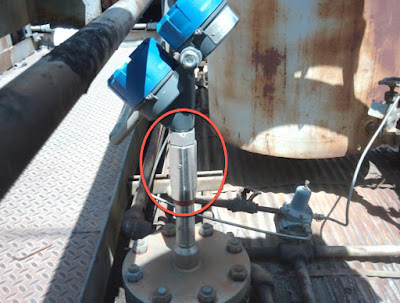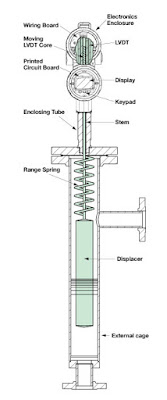 |
| An installed view of the Model 706 Adapter. |
The new Eclipse Model 706 GWR Adapter allows users to keep existing Eclipse 705 GWR probes in place, and upgrade to the Eclipse 706 transmitter and its advanced electronics and DTM.
The ECLIPSE 705 guided wave radar transmitter, with its patented easy-access, angled enclosure has gained wide popularity and has a huge installed base around the world.
The Eclipse 706 transmitter supports both the FDT/DTM and enhanced DD standards. A DTM (Device Type Manager), similar to device drivers used in computers, provides a user-friendly graphical interface to make device configuration, maintenance, diagnostics and troubleshooting a breeze. The DTM allows viewing of valuable configuration and diagnostic information such as the echo curve in tools such as PACTware™, AMS Device Manager, and various HART® Field Communicators.
 In many cases, GWRs are installed in hard to access areas, where removing the sensing probe from
In many cases, GWRs are installed in hard to access areas, where removing the sensing probe from the tank or vessel is prohibitive. Additionally, or the integral electronics and cumbersome DTM of older Eclipse Model 705s is less comprehensive and less user-friendly than the newer Model 706s.
The Model 706 Adapter allows existing Model 705 probes to be retrofitted with the Model 706 transmitter without breaking the process seal, gaining the best-in-class GWR performance that comes along with the Model 706 including the highest Signal-to-Noise (SNR) ratio in the market. High SNR is particularly helpful in low dielectric liquids often found in refineries.
Aside from the increased performance, the technician could now use the latest Model 706 DTM for troubleshooting. The main DTM features emphasized by users are:
- The capability, on a single screen, to view not only the echo curve itself but also the operational conditions of the transmitter along with the configurable parameters. You can then change parameters and refresh the curve to see immediate results without going into multiple screens.
- Data logging capabilities where you can capture all of the data associated with the last nine events, which include configuration parameters, echo curve, echo curve history and event history.
- The Model 706 has the capability to monitor build-up as a percent of level threshold or as a rate. Meaning the user can potentially track the build-up percentage or rate through a HART variable to trigger a flushing process or for timely maintenance / cleaning intervals.
Benefits of the Eclipse® Model 706 GWR Adapter:
- Backwards compatibility with existing Eclipses probes.
- Extends the lifecycle of existing Model 705 probes.
- The added benefit of facilitating the upgrade without opening up the process.
- Lower cost because you are only replacing the transmitter and not the probe.
- Compact design adds 3.15” of installation height.
- Customers get all the features of the Model 706 Transmitter while using their existing Model 705 probes.
- Adapters are in stock at Magnetrol
For more information, contact M.S. Jacobs and Associates. Call them at 800-348-0089 or visit their web site at https://msjacobs.com.


